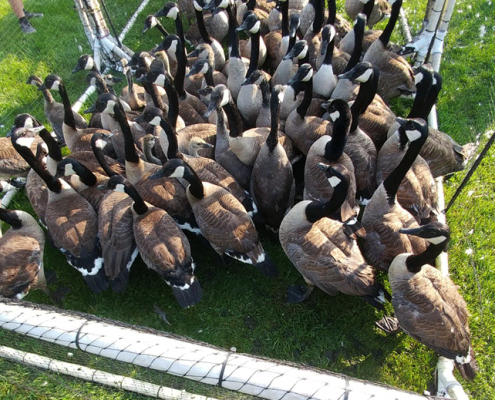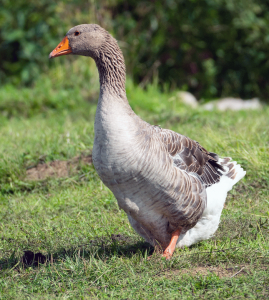
Canadian geese are some of the most common birds in North America. They are found in almost every U.S. state and across Canada during different times of the year.
Canadian Geese Solutions
Canadian geese Description
The Canadian goose is well known because of its distinctive features: long, black neck; white cheeks; webbed feet; and a black head. The crown and bill are also black. Other features of these birds include contrasting white throat and cheek areas, a short tail, white under tail coverts, black feet, dark brown upper wings, back and flank, light brown breast and belly, and short black legs.
It is commonly believed that the size of these birds is reflected in the bodies and necks, with the larger birds having longer necks and more elongated bodies. Scientists have stated that Canadian geese belong to different species, with varying physiology, wingspan, and weight. They also have varying vocalizations. Even with the variation in size, they are mostly large birds, measuring 20 to 50 inches long. Canadian geese have a wingspan of 50 to 68 inches.
The young birds share similar features as ducklings as they have a dark bill and gray and yellow feathers. In the first week, their features change, and they become fuzzy looking. By the 10th week, they begin to look like the adult birds and develop flight feathers.
As expected, they choose their habitat based on access to food, shelter, and water. Thus, habitats of Canadian geese include grain fields and grassy fields. Lawns provide safety and serve as a source of easily digestible food for these birds. When they feed in lawns, they do not lose their line of sight and can easily be warned of a nearby predator. For these reasons, Canadian geese frequent areas with expansive lawns such as airports, golf courses, and parks. There are species that are found on omesticated grasses all through the year causing overpopulation of geese in such areas. Canadian geese also find locations close to rivers, ponds, and lakeshores suitable habitats. The ability of these large birds to populate areas is attributed to the fact that they mate their entire life. Widowed geese find new mating partners and continue to propagate. They mate in open waters.
The diet of Canadian geese changes according to the season. The change in diet pattern is probably to adapt to available resources. During summer and spring, they feed on sedge and grasses. When fall and winter come, they switch to berries and seeds. They particularly eat agricultural grains, and blueberries are a favorite.
These ubiquitous birds make their nests on the ground, preferring elevated sites such as muskrat mounds. Sites that are close to water and elevated are also frequented by these birds for nesting. They choose a site where they can have a very clear view of their surroundings because of the extra security a line of sight provides. As long as a site is deemed safe, nests are created and young ones are hatched. It is not atypical to find their nests in locations such as beside an airport runway.
The nests of Canadian gees are typically made with plant material such as lichens, dry grasses, and mosses. After the open cup-like nest is made with plant materials, body feathers are used to line it. Female geese are typically in charge of making the nests. While the female goose makes the nests and hatches the birds, the male goose stands guard. The female lays a clutch of 2 to 12 eggs. Laying each egg could take over 24 hours.
After laying the eggs, the female incubates them. It takes up to a month to incubate the eggs. When they are fully incubated, the young ones (goslings) break free from the egg by pecking it with their egg tooth which sits at the end of the bill. Goslings are natural swimmers, even diving underwater and feeding continuously to grow and prepare for the migration flight. Typically, the adult birds feed for about 12 hours a day. Before migration flights, the feeding pattern is usually more intense. For up to the first 12 weeks of life, the adult geese are particularly protective of their young, accompanying them when they swim and watching over them in broods.
The migration flight typically occurs when the goslings are at least 9 weeks old. Before this time, the family would have moved from the nesting site to a feeding site. The male and female adult would have also molted. In the molting period, the male and female adults grow new flight feathers and are unable to fly. Families migrate during winter, typically from Canada to other North American locations like Mexico and the US. They could also spend winter in some parts of Canada. After several migration flights, the goslings typically learn the migration route from their parents.
Canadian geese are known for the v pattern of their migration flights. The leader of the flight is typically at the front and the other birds behind it. The V-shape is suitable for energy storage, coordination of movement, and speedy flights. Although they can travel up to 1,500 miles in a day, migration flights are typically leisurely with rest stops.
Except when they are nesting, geese are typically found in flocks. However, their social behaviors differ according to the season. During spring and summer, Canadian geese are more social, breaking out of flocks and even gathering at food sources because of the limited food supply.
Canadian geese make a variety of loud sounds. They honk, hiss, bark, murmur, and cackle, amongst others. Adult geese can make up to 13 different types of sounds. These sounds are heard when they make migration flights, feed, greet, and send out alarm calls. The smallest species are known as cackling geese because of the sound they make. It is said that even goslings can communicate with their parents from within the egg. During migration flights, they typically honk loudly.
Although Canadian geese are known as waterfowls, they live on land and water and their characteristic web feet give away their tracks.
 Geese overpopulation can become a serious problem because of the level of destruction that could come with it. These birds choose a site for feeding and nesting. When they choose a site for nesting, finding the nest is one of the major ways of telling that you may be dealing with a geese nuisance. Let's go through what a geese nest looks like and other ways you can tell if geese are nesting.
Geese overpopulation can become a serious problem because of the level of destruction that could come with it. These birds choose a site for feeding and nesting. When they choose a site for nesting, finding the nest is one of the major ways of telling that you may be dealing with a geese nuisance. Let's go through what a geese nest looks like and other ways you can tell if geese are nesting.
Female geese make nests where they lay and incubate their eggs. Eggs are laid in clutches, and one clutch can have up to 12 eggs. Generally, geese have a life expectancy of 25 years. In this time, they choose partners and create multiple families. From when they are 3 years old, they choose partners and begin to mate. Since geese are highly monogamous, they may have only one partner in their lifetime. If the partner dies, they can choose to remain single or choose a new partner.
It is noteworthy that geese tend to return to the area where they were born to mate and nest. Even migratory geese fly long distances to return to the area where they were born to begin their families. They could also mate and nest around a nearby pool or other bodies of water.
Suitable sites for creating nests include locations close to water and isolated areas. After finding a suitable nesting site, the female builds the nest on the ground. Geese nests are built with plant materials such as dry shrubs, lichens, and mosses. After laying the plant materials, the female then lays body feathers. The nests are usually bowl-shaped and are lined with feathers from the breast area of the female. The diameter of the nest can range from 12” to 40”.
The female lays the eggs at about a rate of 1 egg per day. She then goes on to incubate them. The incubation period ranges from 28 to 30 days. During this period, the female goose will mostly sit on the nest. Whenever she has to go out, she covers the nest with sticks to keep the goslings safe. The sticks also serve as camouflage. The male protects the nest, when the female is sitting on it and when she goes out. When she goes out, he stands a reasonable distance away while guarding it to avoid leading a predator to the nest.
Geese can create nests in a wide variety of locations. They include muskrat houses, islands on bodies of water, under shrubs, in thick aquatic vegetation, along distances of shorelines, in flower boxes and landscaping structures, in hallways, and on concealed structures such as rooftops.
Because geese do not recognize humans as predators, it is not unusual to find their nests in somewhat open places such as parks. Apart from finding the nest, signs that geese are nesting or about to nest include squawking and fighting, finding one goose or sometimes two geese in a strange place, aggressive behaviors, and pecking and attacking glass windows and doors.
 Geese are found around humans. They are found in parks, farms, shorelines of lakes, and even doorways of homes. With the close proximity of these birds to humans, it is important to consider whether any harm can come from a close relationship with geese. Are geese dangerous? Do they carry diseases? Let’s answer these questions below.
Geese are found around humans. They are found in parks, farms, shorelines of lakes, and even doorways of homes. With the close proximity of these birds to humans, it is important to consider whether any harm can come from a close relationship with geese. Are geese dangerous? Do they carry diseases? Let’s answer these questions below.
Are geese dangerous?
Geese have lived in close proximity to humans for a long time. Thus, they do not consider humans as predators or any major form of threat. However, the same cannot be said about humans. Geese can become quite dangerous to humans.
It is not atypical to hear of someone that has been chased or bitten by a goose. Although geese mostly live peacefully in human surroundings, they can become very aggressive. Apart from biting, which is usually not painful, and chasing, geese attacks can lead to broken bones and even death.
Geese are usually aggressive and dangerous during the nesting season. During this season, a pair settles in a chosen site, builds a nest, and raises a family. While the female lays the eggs and incubated them, the male ensures the security of the family. During this period, if you intrude into the nesting site, the gander could perceive even the most innocent act as a threat to the safety of his family and attack.
Because of the close relationship geese have maintained with humans, they build their nests in spaces that humans frequent such as golf courses and parks. Thus, one can mistakenly invade the nesting site while carrying out everyday activities. When the gander perceives an act as a threat to the safety of his family, it squawks and charges. To reduce the danger associated with these situations, calmly retreat.
Do geese carry diseases?
CDC advises limited contact with ducks, chicken, and geese. This is because they can be sources of diseases. Geese can spread diseases through direct contact, as well as through their feces.
The types of disease-causing organisms they carry include the following.
E. coli: Harmful strains of E. coli can cause diseases such as Crohn's disease, gastroenteritis, and urinary tract infections. Persons infected with the pathogen can manifest common symptoms of food poisoning such as diarrhea and vomiting.
Salmonella: This organism comes from a similar family to E. coli and can cause similar symptoms. Symptoms of infection include abdominal cramps, vomiting, and fever. When it is not properly treated and the organisms become stronger, it can lead to death.
Campylobacter: Campylobacter infection comes with symptoms similar to E. coli and Salmonella. Although the symptoms may not be severe, the infection could become complicated and lead to arthritis and irritable bowel syndrome.
The spores of the fungus that cause histoplasmosis can also be found in the feces of geese. The feces also hold giardia and coccidia.
To answer the questions that prompted this article: Yes, geese can be dangerous. Contact with geese, the eggs, and feces can also lead to infections. As you make contact with these birds, it is important to understand what the contact may imply.
